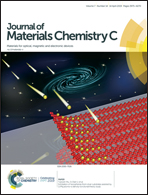Formation of DY center as n-type limiting defects in octahedral semiconductors: the case of Bi-doped hybrid halide perovskites†
Abstract
It is well known that the DX center is a kind of defect that limits n-type doping in some tetrahedrally coordinated semiconductors. It is a deep negatively charged defect complex converted from a nominally shallow donor defect, which can serve as a trap center for electrons, and thus is detrimental to the performance of optoelectronic devices. Similar to the DX center, we find that a donor-yielded complex center (DY center) also exists in six-fold coordinated semiconducting materials. For example, Bi is commonly expected to be a shallow n-type dopant in perovskite APbX3. However, our first-principles calculations show that the DY center is formed in Bi-doped MAPbBr3 when the Fermi level is high in the band gap, but, interestingly, it does not form in MAPbI3. The reason that the DY center is formed in MAPbBr3 instead of MAPbI3 is attributed to the high conduction band minimum (CBM) of MAPbBr3. Our results are able to explain recent puzzling experimental observations, and the thorough discussions on the formation and the properties of the DY center in perovskites provide enlightening insights into the defect study in six-fold coordinated semiconductors.



 Please wait while we load your content...
Please wait while we load your content...